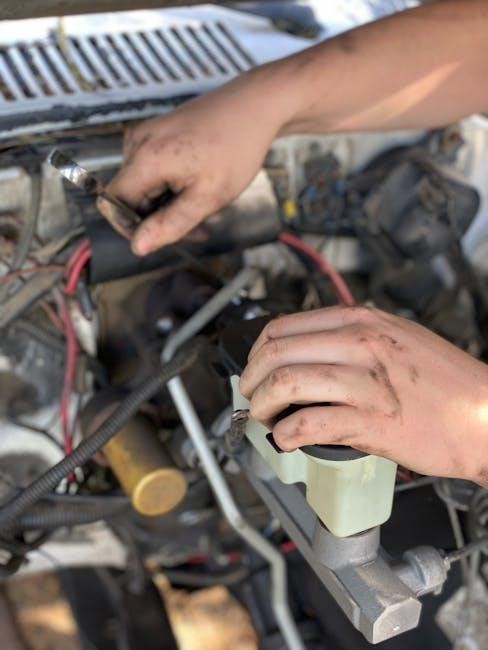
A manual garage door parts diagram provides a visual guide to understanding essential components like hinges, cables, and springs. It aids in identifying parts for maintenance and repair, ensuring smooth operation. Moving Up Garage Door Company offers detailed diagrams and expert resources for installation and troubleshooting.
1.1 Overview of Manual Garage Door Components
A manual garage door parts diagram outlines key components, including hinges, brackets, cables, torsion springs, and rollers. These parts work together to ensure smooth door operation. The diagram highlights essential elements like panels, tracks, and pulleys, providing a clear visual guide. Moving Up Garage Door Company offers detailed diagrams, covering everything from hinges to torsion springs. This overview helps users identify components, understand their functions, and perform maintenance or repairs effectively. By exploring the diagram, homeowners can gain insights into how each part contributes to the door’s functionality and safety. This knowledge is crucial for troubleshooting and ensuring proper door mechanics.
1.2 Importance of Understanding Garage Door Parts
Understanding manual garage door parts is crucial for safety, maintenance, and cost-effective repairs. Knowing each component’s function helps in identifying issues early, preventing accidents and costly breakdowns. It allows homeowners to perform DIY maintenance and repairs confidently, ensuring proper installation or replacement of parts. Moving Up Garage Door Company provides detailed diagrams and expert resources, aiding in troubleshooting and enhancing safety and functionality. This knowledge is essential for maintaining smooth operation and extending the door’s lifespan, enabling users to address problems efficiently and make informed decisions for optimal performance and longevity.
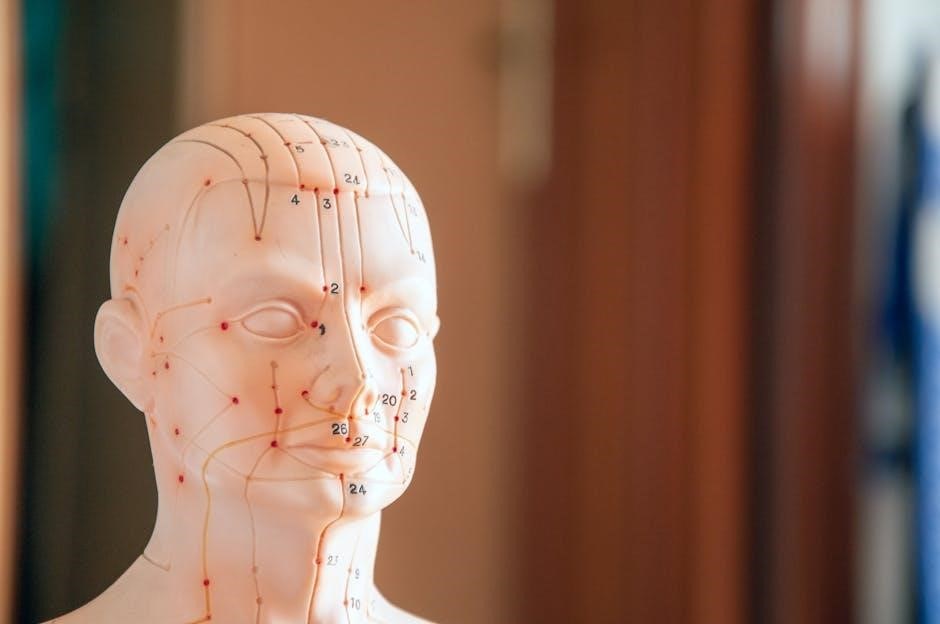
Major Components of a Manual Garage Door
A manual garage door consists of key components like springs, cables, hinges, tracks, and panels. These parts work together to ensure smooth operation and structural integrity, as detailed in the diagram.
2.1 Springs (Torsion and Extension)
Torsion springs are mounted above the door and store energy by twisting, while extension springs stretch along the tracks. Both types counterbalance the door’s weight, ensuring smooth opening and closing. Torsion springs are more common due to their durability and safety. Extension springs are simpler but less secure. Proper spring tension is crucial for balanced operation. Moving Up Garage Door Company offers detailed diagrams highlighting these components. Always refer to a professional for spring adjustments, as improper handling can be dangerous. Understanding the difference between torsion and extension springs is key to maintaining and repairing your manual garage door system effectively.
2.2 Cables and Cable Drums
Cables play a crucial role in the operation of manual garage doors, connecting the door panels to the spring system. They are attached to the bottom brackets and wind around cable drums located near the springs. Torsion springs power the cables, which lift and lower the door smoothly. Extension springs also rely on cables to stabilize the door’s movement. Properly tensioned cables ensure balanced operation and prevent misalignment. However, frayed or damaged cables can compromise safety and functionality. Regular inspection is essential to identify wear and tear. Moving Up Garage Door Company provides detailed diagrams and resources for understanding and maintaining cables and cable drums effectively. Always consult a professional for repairs to avoid risks associated with high tension cables.
2.3 Hinges and Brackets
Hinges are essential for connecting garage door panels and enabling smooth vertical movement. They are typically made of durable materials like steel and are designed to withstand heavy use. Brackets attach hinges to the door frame, providing stability and support. Different types of hinges, such as standard and heavy-duty, cater to varying door sizes and weights. Proper alignment and secure fastening of hinges and brackets are critical for ensuring the door operates safely and efficiently. Over time, hinges may wear out and require lubrication or replacement. Detailed diagrams from Moving Up Garage Door Company highlight the importance of hinges and brackets in maintaining structural integrity. Regular maintenance helps prevent issues like misalignment or noise.
2.4 Tracks and Rollers
Tracks are the metal rails that guide the garage door’s movement, while rollers are the wheels that move along these tracks. Tracks can be vertical or horizontal, depending on the door’s design; Rollers are typically made of nylon or steel and are attached to the door’s hinges. Proper alignment of tracks and rollers is crucial for smooth operation. Misaligned tracks can cause the door to jam or operate noisily. Regular lubrication of rollers ensures quiet and efficient movement. Over time, rollers may wear out and need replacement. Detailed diagrams from Moving Up Garage Door Company highlight the importance of tracks and rollers in ensuring the door’s stability and functionality. Proper maintenance can extend their lifespan and prevent operational issues.
2.5 Panels and Sectional Construction

Garage doors are typically constructed from multiple panels connected in a sectional design, allowing the door to bend and move along the tracks. Each panel is attached to hinges that enable flexibility as the door opens and closes. The panels are usually made of durable materials like steel, wood, or aluminum, ensuring strength and weather resistance. The frame surrounding the panels provides structural integrity, while weatherstripping between them seals gaps to prevent air and moisture infiltration. Panels can vary in size and design for aesthetic or functional purposes, such as insulation for temperature regulation. Damage to individual panels can often be repaired or replaced without needing to replace the entire door. This modular design enhances both functionality and maintenance efficiency.
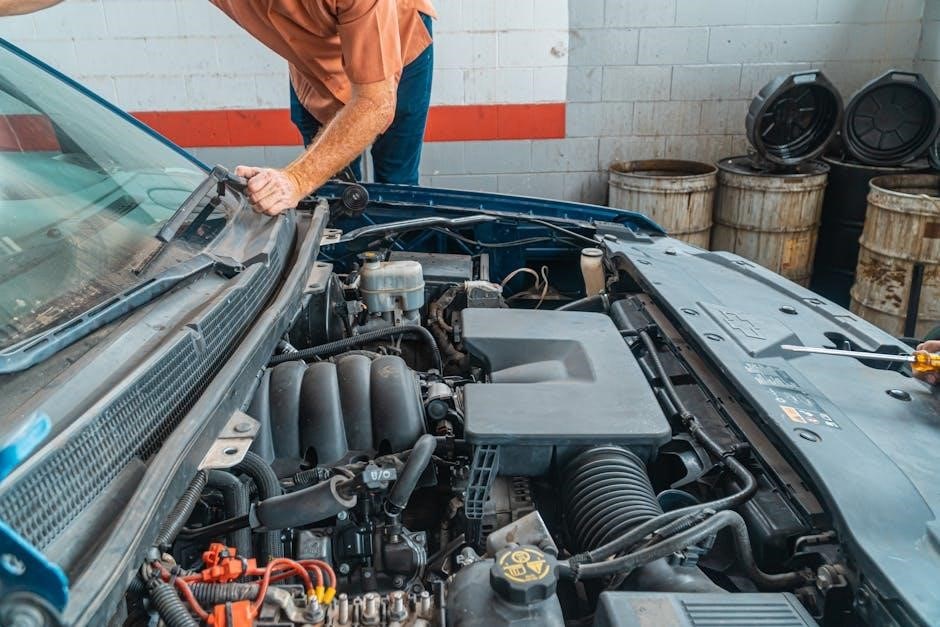
Hardware and Fasteners
Hardware and fasteners, including nuts, bolts, screws, washers, and bearings, are essential for securing and stabilizing the garage door’s structure. Proper tightening ensures smooth operation and longevity.
3.1 Nuts, Bolts, and Screws
Nuts, bolts, and screws are critical fasteners in a manual garage door system. They secure various components, ensuring stability and proper alignment. Hex-head bolts are commonly used for their strength and ease of installation, while lag screws are employed for heavier loads. Nuts, such as wing nuts or locknuts, provide a tight grip to prevent loosening over time. Stainless steel or galvanized materials are preferred for durability and resistance to rust. Proper sizing and torque are essential to avoid stripping threads or damaging parts. Regular inspection and tightening of these fasteners are vital for maintaining smooth door operation and preventing potential safety hazards.
3.2 Washers and Bearings
Washers and bearings play a crucial role in the smooth operation of manual garage doors. Washers, such as flat washers or lock washers, are used to distribute the load of bolts and screws, preventing metal-on-metal contact and reducing wear. Bearings, including roller bearings and ball bearings, are integrated into rollers and hinges to minimize friction during door movement. These components are typically made of durable materials like steel or nylon to withstand heavy use. Regular lubrication of bearings is essential to maintain efficiency, while washers ensure proper alignment and stability. Inspecting and replacing worn-out bearings and washers can prevent costly repairs and ensure long-term functionality.
3.4 Locking Mechanisms
Locking mechanisms are essential for securing manual garage doors, ensuring safety and preventing unauthorized access. Common types include slide locks, T-handle locks, and deadbolt-style locks. These mechanisms are typically installed on the door panels or framing and are designed to withstand forced entry. High-quality locks often feature reinforced metal construction and weather-resistant finishes. Proper installation and alignment are critical for optimal functionality. Regular maintenance, such as lubricating moving parts, helps prevent rust and ensures smooth operation. Additionally, some locking systems may include secondary security features like anti-pick pins or tamper-proof screws. Choosing the right locking mechanism depends on the door’s design and intended use;

Mechanical Components
Mechanical components include torsion spring systems, extension springs, cables, and pulleys, working together to facilitate smooth door movement and balance the weight effectively for manual operation.
4.1 Torsion Spring System
The torsion spring system is a critical component of manual garage doors, providing the necessary force to lift and lower the door smoothly. It consists of a tightly wound spring mounted on a metal shaft above the door opening. When the door is closed, the spring is under tension, storing potential energy. As the door is opened, the spring unwinds, releasing this energy to assist in lifting the door. The system includes cable drums attached to both ends of the shaft, with cables winding around them to distribute the force evenly. This setup ensures balanced and controlled door movement, reducing the effort required to operate the door manually. Torsion springs are known for their compact design and longevity, making them a popular choice for garage doors. Regular lubrication and inspection are essential to maintain optimal performance and safety.
4.2 Extension Spring System
The extension spring system is another essential mechanism in manual garage doors, operating alongside torsion springs to facilitate smooth door movement. Unlike torsion springs, which are wound tightly, extension springs are stretched horizontally above the door tracks. When the door is closed, the springs are under tension, and when opened, they extend to assist in lifting. Each spring is secured to the door frame and track with pulleys and brackets, ensuring even force distribution. Safety cables are often integrated to prevent loose springs from causing damage or injury if they break. This system is simpler to install and maintain compared to torsion springs, making it a popular choice for lightweight manual garage doors. Regular inspection and lubrication of pulleys are crucial for optimal performance.
4.3 Cable Tensioning
Cable tensioning is a critical aspect of maintaining a manual garage door’s functionality. Properly tensioned cables ensure the door opens and closes smoothly, balancing the weight effectively. If the cables are too loose, the door may not operate correctly, while over-tensioning can lead to premature wear. Adjustments are typically made at the cable drums or pulleys, requiring precise tools to avoid misalignment. Regular checks are essential to maintain optimal tension, ensuring safety and preventing potential hazards. Incorrect tensioning can cause uneven door movement or even cable failure, highlighting the importance of accurate adjustment. Proper cable tensioning enhances overall door performance and longevity.
4.4 Pulley and Drum Assembly
The pulley and drum assembly plays a vital role in the smooth operation of a manual garage door. These components work in tandem with cables and springs to redirect and balance the door’s weight. The pulleys, typically mounted on the door frame or ceiling, guide the cables smoothly, while the drums, attached to the spring shaft, wind and unwind the cables during operation. Proper alignment and installation are crucial to ensure even load distribution and prevent wear. Regular inspection and lubrication of moving parts are recommended to maintain optimal performance. A malfunctioning pulley or drum can lead to uneven door movement or complete system failure, emphasizing the need for timely maintenance and replacement.
Safety Features
Manual garage doors incorporate essential safety features to prevent accidents and ensure secure operation. These include mechanisms to prevent crushing and components that stabilize the door during movement.
5.1 Safety Cables for Extension Springs
Safety cables for extension springs are essential to prevent injuries and damage in case of spring failure. These cables are installed through the center of extension springs and securely anchored to the garage door or wall. If an extension spring breaks, the safety cable ensures the spring remains contained, preventing it from snapping free and causing harm. This feature is particularly important for manual garage doors, where springs are under constant tension. Regular inspection of safety cables is crucial to ensure they are not worn or damaged, as they play a critical role in maintaining safe door operation and protecting users from potential hazards.
5.2 Safety Sensors and Alarms
Safety sensors and alarms are crucial components in modern manual garage door systems, designed to enhance security and prevent accidents. These sensors detect obstacles or irregularities in the door’s path and trigger alarms or alerts to notify users of potential hazards. Typically installed near the floor or along the door’s edges, they ensure the door stops or reverses if something blocks its movement. Alarms may include audible or visual signals, providing immediate feedback. Regular maintenance of these sensors is essential to ensure they function correctly. Their presence adds an extra layer of protection, especially in homes with pets or children, by minimizing risks associated with door operation.
5.3 Emergency Release Mechanisms
Emergency release mechanisms are vital for manual garage doors, enabling quick disengagement of the door from its opening system during power failures or malfunctions. These mechanisms typically include a red handle or lever located near the door or on the wall. Pulling the handle disconnects the door from the opener, allowing manual operation. Proper installation and regular testing of these mechanisms are essential to ensure functionality in critical situations. They provide a reliable backup system, ensuring safety and accessibility when primary systems fail. Regular maintenance, such as lubricating moving parts, helps maintain their effectiveness. This feature is indispensable for homeowner safety and convenience.
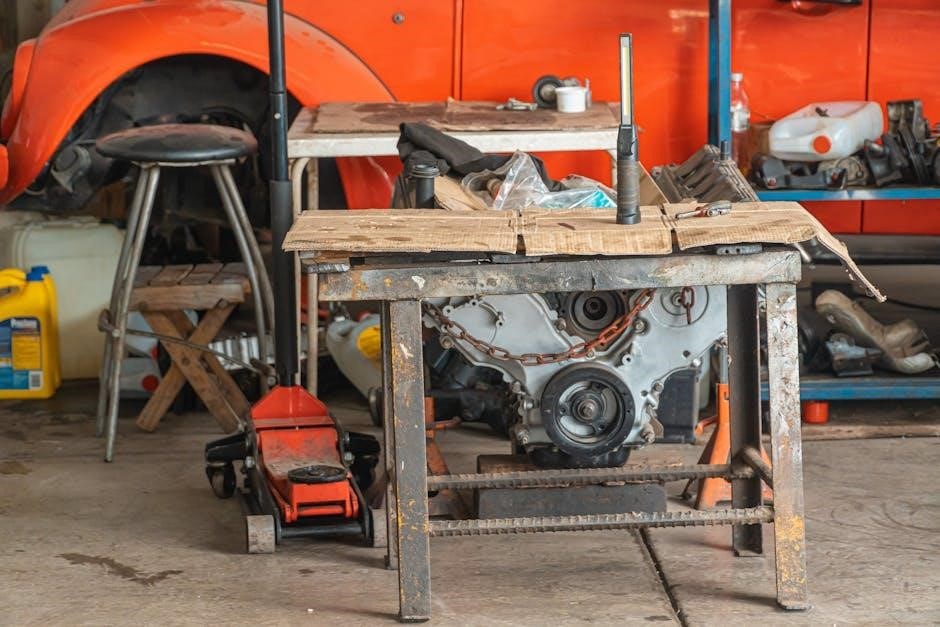
Tools and Equipment Needed
A socket set, pliers, screwdrivers, wrench, and lubricant are essential for adjustments and repairs. Clamps and a level ensure proper alignment and stability during maintenance tasks.
6.1 Essential Tools for Maintenance
For regular maintenance, a socket set, adjustable wrench, screwdrivers (both Phillips and flathead), pliers, and a lubricant are indispensable. These tools help tighten loose parts, lubricate hinges, and adjust rollers. A ladder or step stool is often necessary for reaching high components. A torque wrench ensures proper tensioning of bolts without over-tightening. Additionally, a clamp or vice can hold parts in place while working. Safety glasses and gloves are recommended to protect against potential hazards. Having these tools readily available simplifies routine checks and minor adjustments, ensuring smooth operation and preventing major issues from developing.
6.2 Specialized Tools for Repair
Specialized tools are essential for more complex repairs. A spring winding bar is necessary for safely adjusting or replacing torsion springs, while a cable tightener helps manage garage door cable tension. A drum roller replacement tool is useful for removing and installing worn-out rollers. Additionally, a bearing puller may be needed to remove old bearings from hinges. A garage door tester can ensure proper operation after repairs. These tools are designed for precise adjustments and safety, making them indispensable for addressing specific issues. While they may require some expertise, they are vital for ensuring long-term functionality and safety of the garage door system.
6.3 Safety Gear and Protective Equipment
When working on manual garage door repairs, safety gear is crucial. Essential items include sturdy gloves to prevent cuts and abrasions, safety goggles to protect eyes from flying debris, and a dust mask for inhaling particles. Steel-toe boots or sturdy footwear safeguard feet from heavy tools or falling parts. A hard hat is recommended if working near overhead components. Additional gear like knee pads can reduce discomfort during prolonged tasks. Reflective vests improve visibility in low-light conditions. Always ensure proper fitting and compliance with safety standards. Using protective equipment minimizes injury risks and ensures a safer working environment, especially when handling heavy or sharp parts.

Maintenance and Repair Tips
Regular lubrication of moving parts, tightening loose hardware, and inspecting springs and cables are essential for smooth operation. Addressing worn components early prevents major issues and extends lifespan.
7.1 Lubrication of Moving Parts
Lubricating moving parts is crucial for smooth garage door operation. Apply silicone-based spray lubricant to hinges, rollers, and springs every 6-12 months. Avoid grease, as it attracts dust. Focus on pivot points and wipe off excess with a cloth. Lubricate cable drums and pulleys sparingly to prevent grime buildup. Spring lubrication ensures even tension and reduces wear. Regular lubrication minimizes friction, quiets door movement, and prevents corrosion. Always refer to the manual for specific lubrication recommendations. Proper maintenance extends component lifespan and ensures reliable performance.
Inspect for worn parts during lubrication to address issues early.
7.2 Tightening Loose Hardware
Tightening loose hardware is essential for maintaining garage door stability and safety. Inspect all bolts, screws, and nuts regularly, especially after heavy use. Use a socket wrench or screwdriver to secure loose fasteners. Brackets, hinges, and track mounts are common areas where hardware may loosen. Tighten gradually to avoid over-tightening, which can damage threads. Check spring brackets and cable drums for any signs of wear. Lubricate moving parts after tightening to ensure smooth operation. Regular tightening prevents door misalignment and reduces the risk of accidents. Always refer to the manual for torque specifications. Consistent hardware checks ensure long-term durability and reliable performance.
Address loose parts promptly to avoid further damage.
7.3 Replacing Worn-Out Components
Replacing worn-out components is crucial for maintaining the functionality and safety of a manual garage door. Begin by identifying damaged parts through visual inspection or performance issues like noise or uneven movement. Common replacements include rollers, hinges, cables, and springs. Always refer to the garage door parts diagram for accurate identification; When replacing, ensure compatibility with your specific door model. For springs, consider professional assistance due to high tension risks. For other parts, use appropriate tools like wrenches or cable cutters. After replacement, lubricate moving parts to ensure smooth operation. Regular replacement prevents further damage and enhances door performance. Always follow safety guidelines to avoid accidents.

Troubleshooting Common Issues
Identify and resolve common garage door issues like uneven alignment, noisy operation, or faulty opening/closing mechanisms using the manual garage door parts diagram for accurate diagnostics.
8.1 Door Not Opening or Closing Properly
A malfunctioning garage door can stem from misaligned tracks, worn-out rollers, or broken cables. Inspect the tracks for bends or obstructions and straighten or replace them if needed. Check rollers for damage and replace them with durable alternatives. Frayed or snapped cables should be professionally repaired to avoid further damage. Additionally, ensure the torsion springs are balanced and intact, as uneven tension can hinder proper movement. Lubricate hinges and rollers regularly to reduce friction. If issues persist, consult a manual garage door parts diagram to identify and address specific components effectively.
8.2 Noisy Door Operation
Noisy garage door operation often results from worn or dry moving parts. Lubricate hinges, rollers, and springs with a silicone-based spray to reduce friction. Inspect rollers for wear and replace them if they show signs of damage. Tighten loose bolts or screws on hinges and brackets, as rattling hardware can cause noise. Check the tracks for debris or misalignment, as obstructions can lead to grinding sounds. Replace any damaged or corroded components promptly. Regular maintenance, such as lubrication and inspection, can prevent excessive noise. Refer to a manual garage door parts diagram to locate and address noisy components effectively.
8.3 Uneven Door Alignment
Uneven garage door alignment can cause improper closing and potential damage. Check the tracks for proper alignment using a level. If tracks are bent or misaligned, adjust them carefully. Loose hardware on hinges or brackets may also cause unevenness, so tighten all bolts and screws. Inspect rollers for wear, as damaged rollers can disrupt alignment. Replace any worn-out parts immediately. Ensure the door panels are securely attached to the frame. If the issue persists, consult a manual garage door parts diagram to identify and realign components correctly. Proper alignment ensures smooth operation and prevents further damage to the door and its mechanisms.
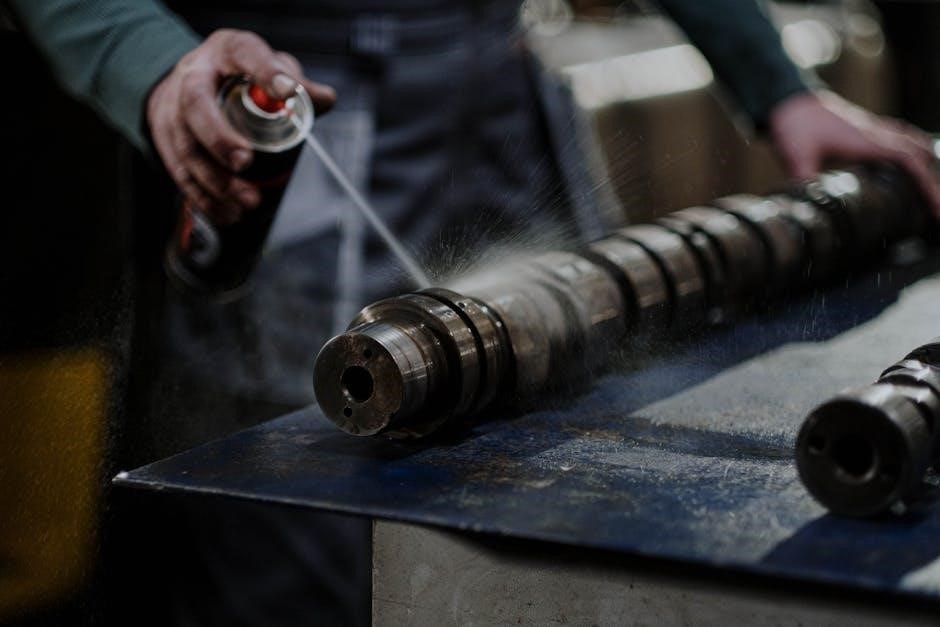
Detailed Diagram and Labeling
A detailed diagram provides a visual guide to identify and understand each part of the manual garage door, ensuring proper maintenance and repair.
9.1 Visual Representation of Parts
A detailed manual garage door parts diagram provides a clear visual representation of each component, making it easier to identify and locate them. High-quality images or illustrations are often used to showcase the door’s structure, including springs, cables, rollers, and hinges. This visual guide helps users understand how parts interact and function within the system. Color-coded labels or numbered annotations are commonly included to highlight specific components, ensuring clarity. The diagram may also illustrate the door’s sectional construction, allowing users to visualize how panels and tracks align. This feature is essential for DIY repairs and maintenance, as it helps users pinpoint issues and understand the relationship between parts.
9.2 Labeling and Identification Guide
A comprehensive labeling and identification guide accompanies the manual garage door parts diagram, ensuring users can easily recognize and locate each component. Each part is typically labeled with a number or letter, corresponding to a key or chart. This guide helps users match visual elements in the diagram to their physical counterparts. Critical components like springs, cables, and hinges are often highlighted for quick identification. The guide may also include color-coding or symbols to differentiate between similar parts. By following the labeling system, users can efficiently navigate the diagram and understand the role of each part. This feature is invaluable for maintenance, repairs, and ensuring safety while working on the door.
9.3 Interactive Diagram Features
Interactive diagrams offer enhanced user engagement by incorporating dynamic elements. Zoom functionality allows users to enlarge specific sections for detailed inspection. Hover-over text provides instant information about each part, aiding in quick identification. Clickable components can link to repair guides or maintenance tips. A search function enables users to find parts swiftly. Animations demonstrate mechanical movements, clarifying how components interact. These features collectively enhance understanding and facilitate effective garage door maintenance. By integrating these tools, the diagram becomes an indispensable resource for both novices and experienced users, ensuring efficient and safe repairs. This interactivity makes complex information accessible and user-friendly, promoting a smoother experience overall.

Resources and References
Explore manufacturer websites, hardware stores, and online forums for detailed diagrams and repair guides. Official manuals and DIY communities provide valuable insights and troubleshooting tips.
10.1 Where to Find Detailed Diagrams
Detailed diagrams for manual garage door parts can be found in manufacturer-specific repair manuals or on official websites. Hardware stores like Home Depot or Lowe’s often provide schematic guides. Online marketplaces such as Amazon may include diagrams with product listings. Additionally, DIY repair forums and websites like iFixit or Instructables offer visual breakdowns. Local libraries or community centers may also have access to such resources. Always ensure diagrams are relevant to your specific garage door model for accurate identification and repair. Using verified sources guarantees reliability and safety during maintenance or installation processes.
10.2 Recommended Repair Manuals
Recommended repair manuals for manual garage doors are available from manufacturers like Chamberlain, LiftMaster, and Clopay. These manuals often include detailed diagrams and step-by-step instructions. Online retailers such as Amazon offer a wide selection of garage door repair manuals. Specialty hardware stores and home improvement centers may also carry these resources. DIY communities and forums frequently recommend specific manuals based on user experiences; When selecting a manual, ensure it aligns with your garage door model and includes both written instructions and visual guides. These resources are invaluable for troubleshooting and performing repairs safely and effectively.
10.3 Online Communities and Forums
Online communities and forums are excellent resources for troubleshooting and understanding manual garage door parts diagrams. Websites like Reddit’s r/HomeImprovement and specialized forums such as Garage Door Talk offer valuable insights. Facebook groups dedicated to DIY home repairs often share detailed experiences. These platforms allow users to ask questions, share diagrams, and receive advice from experienced individuals. Many forums feature threads with step-by-step repair guides and recommendations for tools. Additionally, some communities provide access to downloadable repair manuals and interactive diagrams. Engaging with these online spaces can help you identify and resolve issues efficiently, leveraging the collective knowledge of the community.